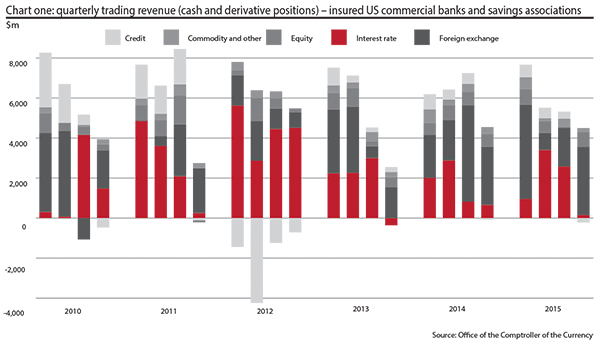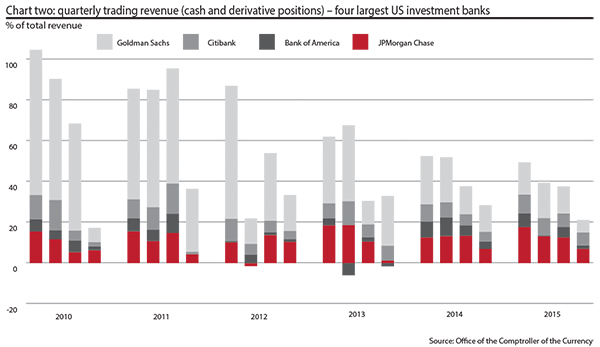Trading revenue in the US is expected to fall in the first quarter of 2016. However, 2015 was still the best year for trading since 2011.
While trading revenue tends to be the highest in the first quarter of the year, the largest banks in Europe and the US are already expecting trading to have plunged in the first three months of 2016 on the back of a slowdown in China, low commodity prices and low chances of a US rate rise, according to the Financial Times. However, in the US at least, 2015 was the best year for trading since 2011 and the first quarter of 2015 was the strongest performing three months since the first quarter of 2010.
The Office of the Comptroller of Currency (OCC) recently reported that the trading revenue of US commercial banks was $22.79bn in 2015, the best performance since 2011. The improvement over previous years was not large, because US banks earned $22.7bn from trading in 2014 and $22.08bn in the year before. By contrast, in 2011 the trading revenue was $25.28bn.
However, despite a good yearly performance, banks saw a slow fourth quarter of 2015 – revenue from trading fell to $4.28bn, down from $5.32bn in the third quarter. It was also lower than a year before, when US banks earned $4.47bn in the final quarter of 2014.
The OCC report shows that the decline in revenue happened mostly because of the poor performance of interest rate and credit derivatives (see chart one). In the fourth quarter of the year revenue from interest rate trading dropped by $2.42bn to $155m, while revenue from credit trading turned negative, -$222m owing to a $579m drop. On the year-to-year basis, these two revenue sources also posted notable drops.
This decline is partly seasonal, as investors tend to wrap up their trading at the end of the year. With that in mind, the decline at the end of 2015 compares relatively well with other fourth-quarter performances. Foreign exchange trading actually showed improvement – growth of $1.47bn on quarterly basis, increasing revenue in that category to $3.4bn.
The report also shows that the contribution to revenue by trading is changing at the largest banks, and for some, such as Goldman Sachs, it is dropping. The bank used to be highly dependent on trading revenue – in 2010 and 2011 it contributed more than half of the lender's total revenue. Since then, trading has gradually waned and in the final quarter of 2015 its contribution to the bank’s revenue was its lowest yet – only 6.16% (see chart two).
At Bank of America, trading revenue contribution dropped after a rebound in 2014 – the bank faced a challenging 2012 and 2013, when in some quarters trading revenue turned negative. For the two other largest US investment banks, JPMorgan and Citibank, trading revenue contribution appears steady.
According to recent reports, Goldman Sachs is going to take a large hit to its trading income this quarter – the Financial Times estimates that its trading revenue could drop by 31.6%. The three other big US banks are expected to take smaller hits. Citigroup warned in early March that its first-quarter trading revenue is expected to decline 15% relative to 2015, while JPMorgan said in late February that its earnings from the trading business were about 20% lower than the previous year. The Financial Times estimates that Bank of America will see a decrease of little below 20%.




